 W
WThe SEAT 124 is a small family car produced by the Spanish manufacturer SEAT in its Zona Franca, Barcelona and Landaben, Pamplona plants between 1968 and 1980. The car was very successful in Spain having sold 896,136 units, and was produced in 4-door, 5-door station wagon (Familiar) and 2-door coupé (Sport) ( versions under various engines and trim levels.
 W
WThe SEAT 124 Sport is a two-door coupé car built by the Spanish manufacturer SEAT between 1970 and 1975, having sold 23,611 units when its production ceased.
 W
WThe SEAT 127 is a supermini produced by the Spanish automaker SEAT between the spring of 1972 and 1982, based on the Fiat 127.
 W
WThe SEAT 128 is a 3-door hatchback coupé from the Spanish automaker SEAT launched in 1976. Being essentially the three-door hatchback version of the Fiat 128, it was available with two engine options in Spain, the 1.2L and the more powerful and well-known 1430 engine. The design of the SEAT 128 was made in Spain by SEAT engineers, and was marketed as "Three Times SEAT" in order to underline its triple combination ability of sportiness, versatility and design. The car was aimed at rich, young drivers, however, the 128 never enjoyed great commercial success, since in a period of economic recession and transition in Spain most people opted for the smaller, less expensive SEAT 127.
 W
WThe SEAT 131 is a rebadged Fiat 131, a mid-size family car, produced by the Spanish car manufacturer SEAT from 1975 to the middle of 1984. The SEAT 131 was presented on May 1975 in the Barcelona Motor Show.
 W
WThe SEAT 132 is a four door, rear wheel drive notchback saloon presented for the first time at the Barcelona Motor Show, assembled in Barcelona's Zona Franca, and sold by SEAT between 1973 and 1982.
 W
WThe SEAT 133 was a small rear-engined car designed and sold by SEAT in Spain from 1974 to 1979. The car used the chassis and engine of the by then defunct Fiat/SEAT 850 and featured a new body in the style of the contemporary, somewhat smaller and only indirectly related Fiat 126.
 W
WThe SEAT 600 is a city car made in Spain by SEAT from May 1957 to August 1973 under licence from Fiat. It helped to start the Spanish miracle that came at the end of the slow recovery from the Spanish Civil War. It was a relatively inexpensive vehicle and was the first car that came within the modest but rapidly growing economic means of most Spanish families from the mid-1960s to the early 1970s. The vehicle has become an icon of the period.
 W
WThe SEAT 600 is a city car made in Spain by SEAT from May 1957 to August 1973 under licence from Fiat. It helped to start the Spanish miracle that came at the end of the slow recovery from the Spanish Civil War. It was a relatively inexpensive vehicle and was the first car that came within the modest but rapidly growing economic means of most Spanish families from the mid-1960s to the early 1970s. The vehicle has become an icon of the period.
 W
WThe SEAT 850 was a car launched in 1966, based upon the Fiat 850. Originally only available with the same 2-door sedan body as used in Italy, two different 4-door versions also appeared in 1967. The very rare corto (short) used the bodywork developed by Francis Lombardi for the Fiat 850 "Lucciola", while the largo (long) version used a floorpan lengthened by 15 cm and bodywork developed specifically by SEAT. The car was produced in Spain from April 1966 to 1974 and it was quite popular during that time.
 W
WThe SEAT 1200 Sport is a two-door, four-seater coupé developed by the Spanish car maker SEAT. First presented in December 1975, and sold commercially from February 1976 to September 1979, it was the first car developed entirely in the company's newly opened Martorell Technical Centre. Its initial version was powered by the bigger 1,197 cc engine of 67 PS (49 kW), transversely mounted and canted forward by 16°, giving the little 2+2 a top speed of 157 km/h (98 mph) via its four-speed gearbox transmission. Despite its sporting aspirations, its power output was limited by a relatively low compression ratio, reflecting the fuel octane levels available in its home market.
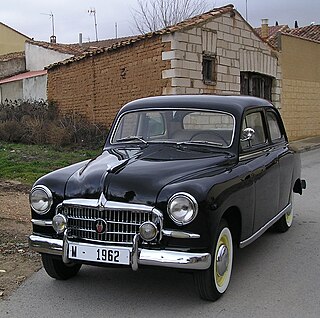 W
WThe SEAT 1400 was a rear-wheel-drive four-door mid-size sedan built by the Spanish car maker SEAT between 1953 and 1963. It was the first model produced by SEAT, and the first car to be assembled at the firm's then-new plant located in Barcelona's Zona Franca zone.
 W
WThe SEAT 1430 was a 4-door sedan made by SEAT in Spain from 1969 to 1975. The car was based on the FIAT 124 Special, but the front lights were the square ones from the FIAT 125 instead of round. The cockpit was almost identical to the Fiat 125. In 1973, the GTI version of the SEAT 1430 was introduced as the 1430 Especial 1600 model, popularly known as "FU". It was superseded by the SEAT 131, while the donor car, the SEAT 124 continued in its base form until 1980.
 W
WThe SEAT 1200 Sport is a two-door, four-seater coupé developed by the Spanish car maker SEAT. First presented in December 1975, and sold commercially from February 1976 to September 1979, it was the first car developed entirely in the company's newly opened Martorell Technical Centre. Its initial version was powered by the bigger 1,197 cc engine of 67 PS (49 kW), transversely mounted and canted forward by 16°, giving the little 2+2 a top speed of 157 km/h (98 mph) via its four-speed gearbox transmission. Despite its sporting aspirations, its power output was limited by a relatively low compression ratio, reflecting the fuel octane levels available in its home market.
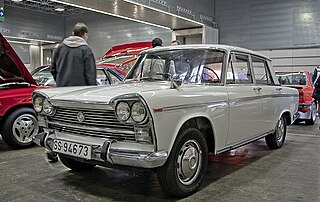 W
WThe SEAT 1500 was a Spanish-built 6-seater model of saloon and estate cars, based on the Italian Fiat 2300 and using a 1481 cc engine from the Fiat 1500. The 1500 was the successor to the SEAT 1400 C; it was manufactured from 1963 to 1973, with the five door estate ("Familiar") version arriving in 1965. Apart from the larger engine, differences between the 1500 and the C version of its predecessor were limited to minor details such as a speedometer that now read up to 140 km/h (87 mph).
 W
WThe SEAT Alhambra is a large multi-purpose vehicle (MPV) that was built from 1996 to 2020. It was manufactured under the SEAT brand from June 1996 at the Volkswagen Group's AutoEuropa plant in Palmela, Portugal. It shares the same platform with the Volkswagen Sharan, and the first generation was also related to the Ford Galaxy. The vehicle is named after the Alhambra of Granada, a famous monument in Spain.
 W
WThe SEAT Altea is a compact multi-purpose vehicle (MPV) produced by the Spanish automaker SEAT from 2004 to 2015. The vehicle was designed by the Italian Walter de Silva, and was launched in March 2004, as the first example of SEAT's new corporate look. The third generation Toledo was identical, except for the addition of a larger boot. It was launched at the 2004 Geneva Motor Show.
 W
WThe SEAT Arona is a subcompact crossover SUV (B-segment) manufactured by SEAT since 2017. It is the smallest crossover SUV offered by the Spanish brand. It slots in below the Ateca compact model and Tarraco seven-seater.
 W
WThe SEAT Arosa is a city car that was manufactured by the Spanish automaker SEAT from 1997 to 2004. The model débuted in March 1997 at the Geneva Motor Show, while its facelifted version was presented in October 2000 at the Paris Motor Show. It shared a platform with the Volkswagen Lupo.
 W
WThe SEAT Ateca is a compact crossover SUV (C-segment) manufactured by Spanish automaker SEAT. The brand's first SUV offering, the Ateca sits in the C-SUV segment, above the Arona and below the Tarraco. It was unveiled as a production vehicle on 1 March 2016 in Barcelona.
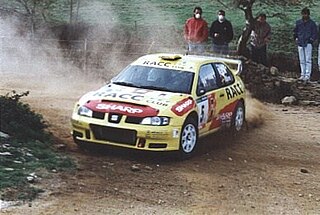 W
WThe SEAT Córdoba WRC is a World Rally Car built for the SEAT Sport by SEAT in the World Rally Championship. It is based upon the SEAT Córdoba road car, and was debuted at the 1998 Rally Finland.
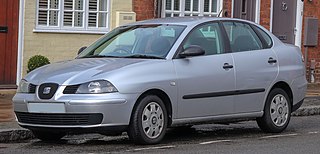 W
WThe SEAT Córdoba is the saloon, estate and coupé version of the SEAT Ibiza supermini car, built by the Spanish automaker SEAT. It was manufactured between 1993 and 2010, and was related with the second and third generations of the Ibiza.
 W
WThe SEAT Exeo is a large family car and flagship model, that was built by the Spanish car manufacturer SEAT, subsidiary of the Volkswagen Group.
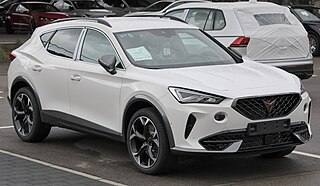 W
WThe Cupra Formentor is a compact crossover SUV (C-segment) manufactured by the Spanish car manufacturer SEAT under their Cupra performance-oriented sub-brand. Marketed as a coupé SUV, it is the first car designed specifically for the sub-brand. The production version was revealed in March 2020 after it was postponed due to the cancellation of the Geneva Motor Show. It was previewed as a near-production concept vehicle at the 2019 Geneva Motor Show. It is named after Formentor peninsula on the Spanish island of Majorca. Production of the Formentor started in late September 2020.
 W
WThe SEAT Fura was a supermini car which was produced by Spanish car manufacturer SEAT between 1981 and 1986, and based on the Fiat 127, which had been built by the firm since April 1972.
 W
WThe SEAT Málaga is a four-door saloon produced by the Spanish automaker SEAT from 1985 to 1991, named after the city of Málaga in Andalucía, southern Spain.
 W
WThe SEAT Ibiza is a supermini car that has been manufactured by Spanish car manufacturer SEAT since 1984. It is SEAT's best-selling car. The Ibiza is named after the Spanish island of Ibiza and was the second SEAT model to be named after a Spanish location, after the SEAT Málaga. It was introduced at the 1984 Paris Motor Show as the first car developed by SEAT as an independent company, although it was designed by SEAT in collaboration with well-known firms including Italdesign, Karmann, and Porsche.
 W
WThe SEAT Inca was a van and panel van produced by the Spanish manufacturer SEAT between 1997 and 2005. It was designed and assembled in Spain, based on the SEAT Ibiza Mark 2. It was first shown at the Barcelona Motor Show of 1996.
 W
WThe SEAT León (Spanish pronunciation: [ˈse.at leˈon], also spelled Leon outside of Spain, is a hatchback compact car built by the Spanish car manufacturer SEAT since October 1998.
 W
WThe SEAT Málaga is a four-door saloon produced by the Spanish automaker SEAT from 1985 to 1991, named after the city of Málaga in Andalucía, southern Spain.
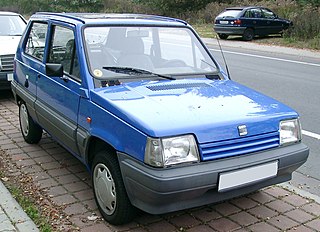 W
WThe SEAT Panda was a badge-engineered Fiat Panda produced by SEAT from 1980 to 1986, in the company's Landaben plant in the Spanish city of Pamplona and also in the Zona Franca plant in Barcelona. After the break in the partnership between SEAT and Fiat, the former's model was restyled and renamed SEAT Marbella. It received a slight restyling in 1983, with a new grille and other slight differences.
 W
WThe SEAT Mii is a city car produced by the Spanish automobile manufacturer SEAT since 2011. It is part of the Volkswagen Group New Small Family (NSF) series of models. It is the successor of the SEAT Arosa which was produced from 1997 to 2004.
 W
WThe SEAT Panda was a badge-engineered Fiat Panda produced by SEAT from 1980 to 1986, in the company's Landaben plant in the Spanish city of Pamplona and also in the Zona Franca plant in Barcelona. After the break in the partnership between SEAT and Fiat, the former's model was restyled and renamed SEAT Marbella. It received a slight restyling in 1983, with a new grille and other slight differences.
 W
WThe Fiat Ritmo is small, front-engine, front-wheel drive family car manufactured and marketed by Fiat, launched in April 1978 at the Turin Motor show and offered in 3- and 5-door hatchback and cabriolet body styles – from 1978 to 1988 with two facelifts.
 W
WThe SEAT Ronda was a small family car produced by the Spanish automaker SEAT from 1982 to 1986, and styled by Rayton Fissore in collaboration with the Technical Centre in Martorell. The Ronda was also briefly sold in the United Kingdom as the SEAT Málaga hatchback. 177,869 Rondas were built in total.
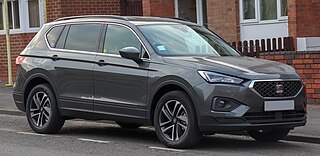 W
WThe SEAT Tarraco is a mid-size crossover SUV manufactured by Spanish automaker SEAT. It is the flagship SUV of the Spanish car maker above the SEAT Arona and the SEAT Ateca, optionally available with seven seats. It is based on the Volkswagen Group's MQB-A2 platform, while closely related to the Volkswagen Tiguan Allspace and the Škoda Kodiaq.
 W
WThe SEAT Panda was a badge-engineered Fiat Panda produced by SEAT from 1980 to 1986, in the company's Landaben plant in the Spanish city of Pamplona and also in the Zona Franca plant in Barcelona. After the break in the partnership between SEAT and Fiat, the former's model was restyled and renamed SEAT Marbella. It received a slight restyling in 1983, with a new grille and other slight differences.
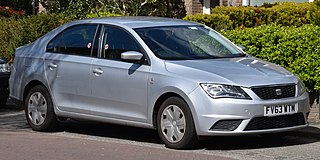 W
WThe SEAT Toledo is a small family car produced by the Spanish manufacturer SEAT, part of Volkswagen Group. The Toledo name was first introduced to the SEAT line up in May 1991, with the fourth generation being introduced at the end of 2012, for the model year of 2013. Production ended in February 2019, and the nameplate is currently not in use.
 W
WThe SEAT Panda was a badge-engineered Fiat Panda produced by SEAT from 1980 to 1986, in the company's Landaben plant in the Spanish city of Pamplona and also in the Zona Franca plant in Barcelona. After the break in the partnership between SEAT and Fiat, the former's model was restyled and renamed SEAT Marbella. It received a slight restyling in 1983, with a new grille and other slight differences.